Fashion Economics: Cultural Traditions, Fashion, and Global Designers
VerifiedAdded on 2020/05/08
|8
|1792
|89
Essay
AI Summary
This essay delves into the fascinating intersection of fashion and culture, exploring how designers draw inspiration from traditional clothing and cultural practices around the world. It examines the global fashion industry's growth, driven by globalization and the sharing of ideas. The essay highlights the significance of preserving cultural heritage through fashion, focusing on designers who blend traditional elements with contemporary styles. It analyzes the work of three prominent designers: Hwang Yi-seul, who modernizes Korean hanbok; Nguyễn Công Trí, who reimagines Vietnamese áo dài; and Lyn-Al Young, who incorporates Aboriginal Australian designs. The essay emphasizes the importance of respecting cultural traditions while integrating them into modern fashion, advocating for judicious and sensitive design practices.
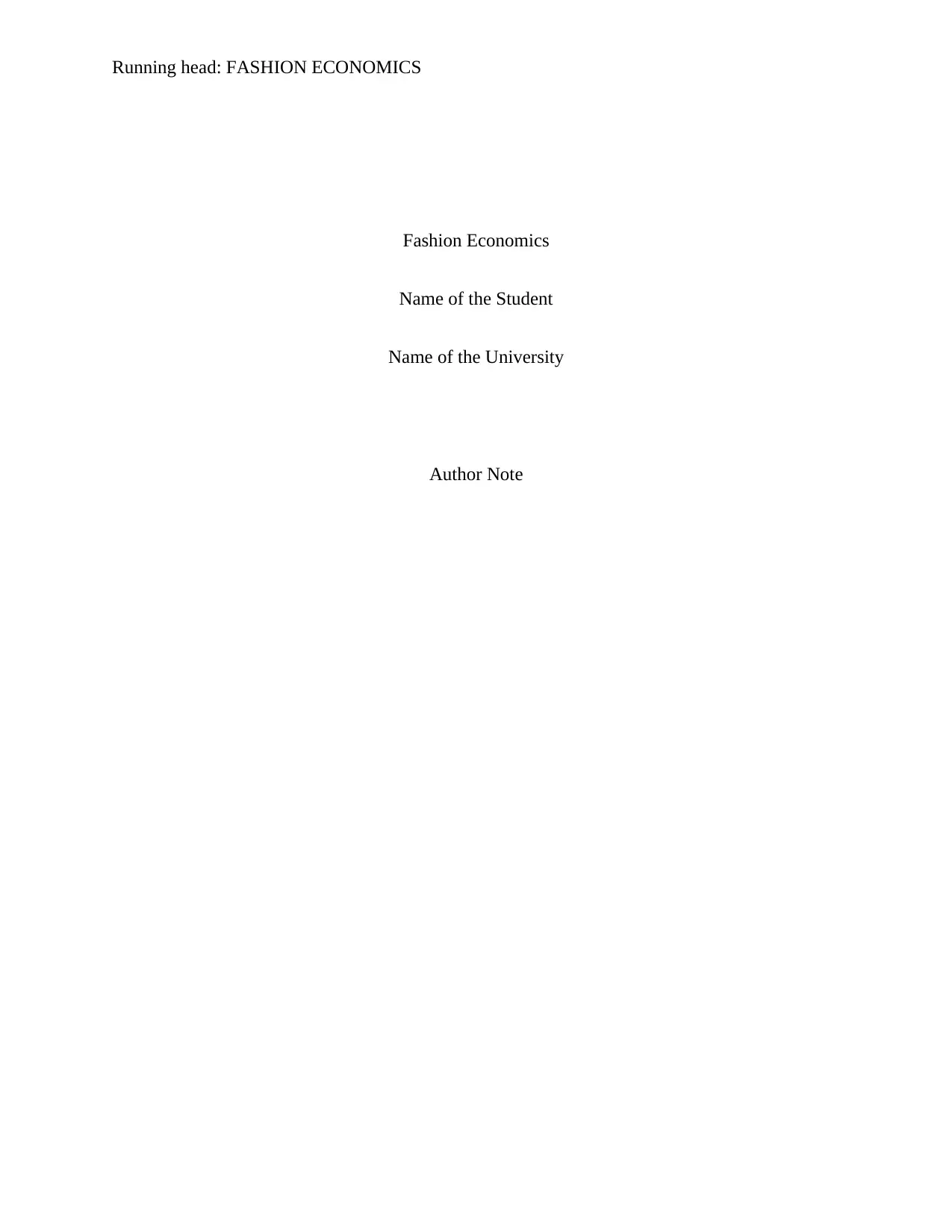
Running head: FASHION ECONOMICS
Fashion Economics
Name of the Student
Name of the University
Author Note
Fashion Economics
Name of the Student
Name of the University
Author Note
Paraphrase This Document
Need a fresh take? Get an instant paraphrase of this document with our AI Paraphraser
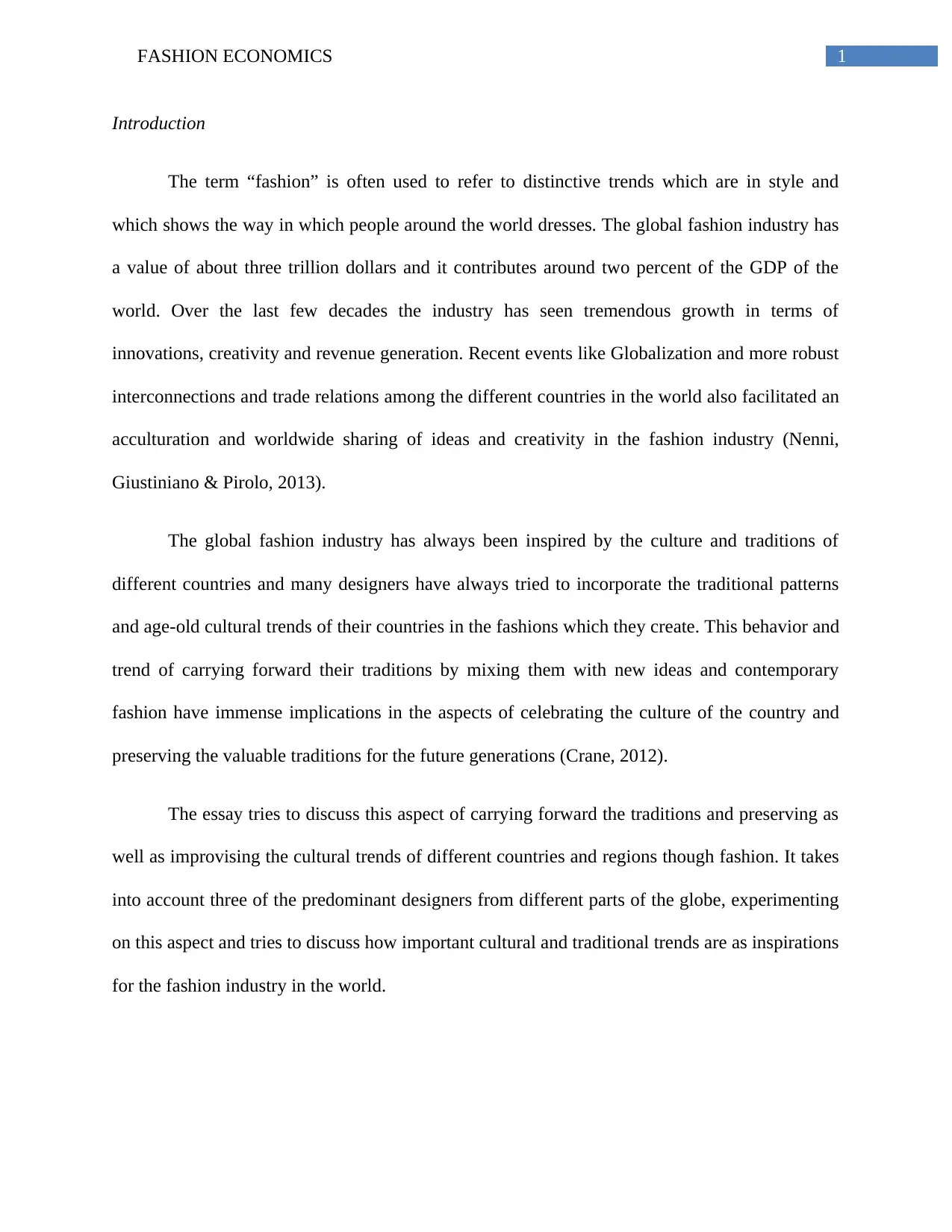
1FASHION ECONOMICS
Introduction
The term “fashion” is often used to refer to distinctive trends which are in style and
which shows the way in which people around the world dresses. The global fashion industry has
a value of about three trillion dollars and it contributes around two percent of the GDP of the
world. Over the last few decades the industry has seen tremendous growth in terms of
innovations, creativity and revenue generation. Recent events like Globalization and more robust
interconnections and trade relations among the different countries in the world also facilitated an
acculturation and worldwide sharing of ideas and creativity in the fashion industry (Nenni,
Giustiniano & Pirolo, 2013).
The global fashion industry has always been inspired by the culture and traditions of
different countries and many designers have always tried to incorporate the traditional patterns
and age-old cultural trends of their countries in the fashions which they create. This behavior and
trend of carrying forward their traditions by mixing them with new ideas and contemporary
fashion have immense implications in the aspects of celebrating the culture of the country and
preserving the valuable traditions for the future generations (Crane, 2012).
The essay tries to discuss this aspect of carrying forward the traditions and preserving as
well as improvising the cultural trends of different countries and regions though fashion. It takes
into account three of the predominant designers from different parts of the globe, experimenting
on this aspect and tries to discuss how important cultural and traditional trends are as inspirations
for the fashion industry in the world.
Introduction
The term “fashion” is often used to refer to distinctive trends which are in style and
which shows the way in which people around the world dresses. The global fashion industry has
a value of about three trillion dollars and it contributes around two percent of the GDP of the
world. Over the last few decades the industry has seen tremendous growth in terms of
innovations, creativity and revenue generation. Recent events like Globalization and more robust
interconnections and trade relations among the different countries in the world also facilitated an
acculturation and worldwide sharing of ideas and creativity in the fashion industry (Nenni,
Giustiniano & Pirolo, 2013).
The global fashion industry has always been inspired by the culture and traditions of
different countries and many designers have always tried to incorporate the traditional patterns
and age-old cultural trends of their countries in the fashions which they create. This behavior and
trend of carrying forward their traditions by mixing them with new ideas and contemporary
fashion have immense implications in the aspects of celebrating the culture of the country and
preserving the valuable traditions for the future generations (Crane, 2012).
The essay tries to discuss this aspect of carrying forward the traditions and preserving as
well as improvising the cultural trends of different countries and regions though fashion. It takes
into account three of the predominant designers from different parts of the globe, experimenting
on this aspect and tries to discuss how important cultural and traditional trends are as inspirations
for the fashion industry in the world.
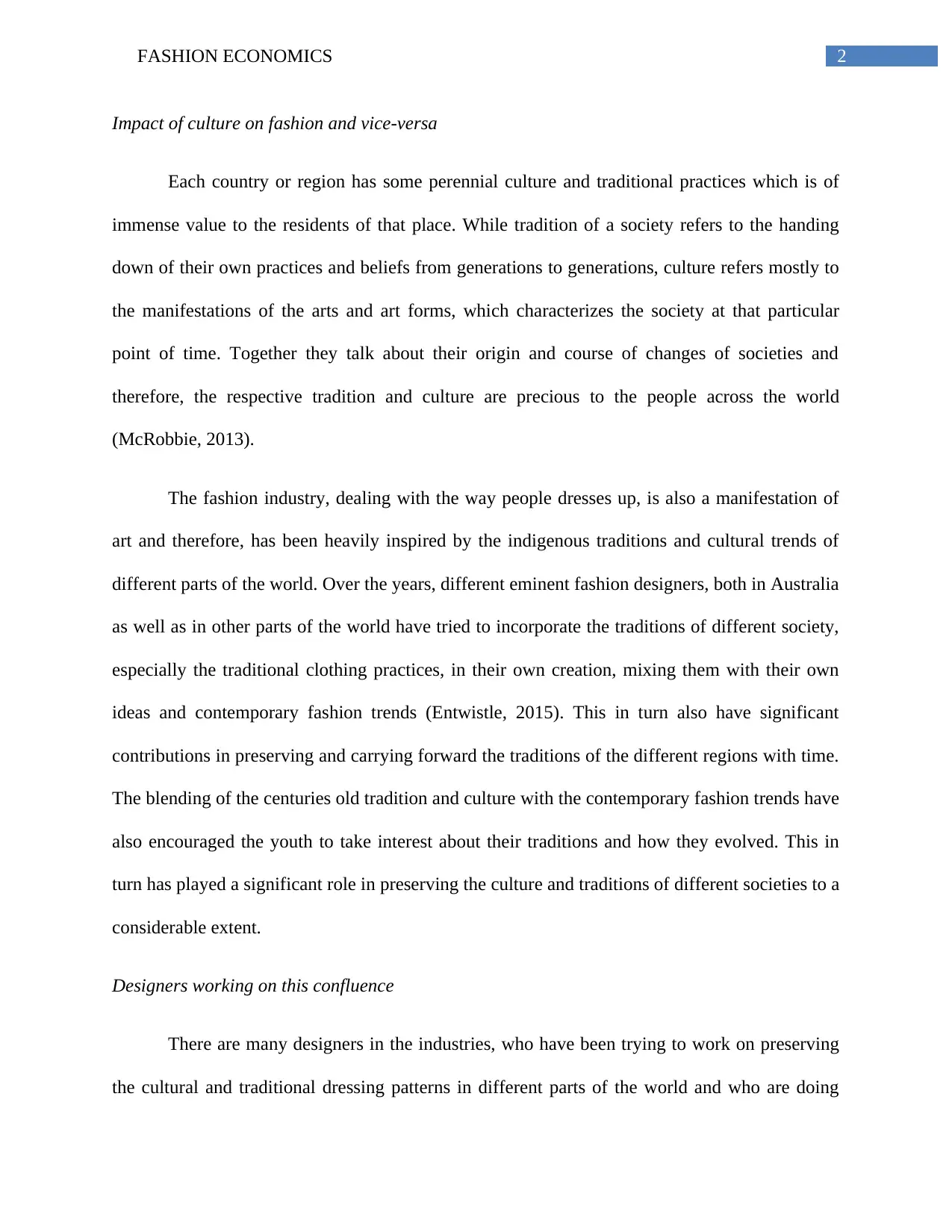
2FASHION ECONOMICS
Impact of culture on fashion and vice-versa
Each country or region has some perennial culture and traditional practices which is of
immense value to the residents of that place. While tradition of a society refers to the handing
down of their own practices and beliefs from generations to generations, culture refers mostly to
the manifestations of the arts and art forms, which characterizes the society at that particular
point of time. Together they talk about their origin and course of changes of societies and
therefore, the respective tradition and culture are precious to the people across the world
(McRobbie, 2013).
The fashion industry, dealing with the way people dresses up, is also a manifestation of
art and therefore, has been heavily inspired by the indigenous traditions and cultural trends of
different parts of the world. Over the years, different eminent fashion designers, both in Australia
as well as in other parts of the world have tried to incorporate the traditions of different society,
especially the traditional clothing practices, in their own creation, mixing them with their own
ideas and contemporary fashion trends (Entwistle, 2015). This in turn also have significant
contributions in preserving and carrying forward the traditions of the different regions with time.
The blending of the centuries old tradition and culture with the contemporary fashion trends have
also encouraged the youth to take interest about their traditions and how they evolved. This in
turn has played a significant role in preserving the culture and traditions of different societies to a
considerable extent.
Designers working on this confluence
There are many designers in the industries, who have been trying to work on preserving
the cultural and traditional dressing patterns in different parts of the world and who are doing
Impact of culture on fashion and vice-versa
Each country or region has some perennial culture and traditional practices which is of
immense value to the residents of that place. While tradition of a society refers to the handing
down of their own practices and beliefs from generations to generations, culture refers mostly to
the manifestations of the arts and art forms, which characterizes the society at that particular
point of time. Together they talk about their origin and course of changes of societies and
therefore, the respective tradition and culture are precious to the people across the world
(McRobbie, 2013).
The fashion industry, dealing with the way people dresses up, is also a manifestation of
art and therefore, has been heavily inspired by the indigenous traditions and cultural trends of
different parts of the world. Over the years, different eminent fashion designers, both in Australia
as well as in other parts of the world have tried to incorporate the traditions of different society,
especially the traditional clothing practices, in their own creation, mixing them with their own
ideas and contemporary fashion trends (Entwistle, 2015). This in turn also have significant
contributions in preserving and carrying forward the traditions of the different regions with time.
The blending of the centuries old tradition and culture with the contemporary fashion trends have
also encouraged the youth to take interest about their traditions and how they evolved. This in
turn has played a significant role in preserving the culture and traditions of different societies to a
considerable extent.
Designers working on this confluence
There are many designers in the industries, who have been trying to work on preserving
the cultural and traditional dressing patterns in different parts of the world and who are doing
⊘ This is a preview!⊘
Do you want full access?
Subscribe today to unlock all pages.

Trusted by 1+ million students worldwide
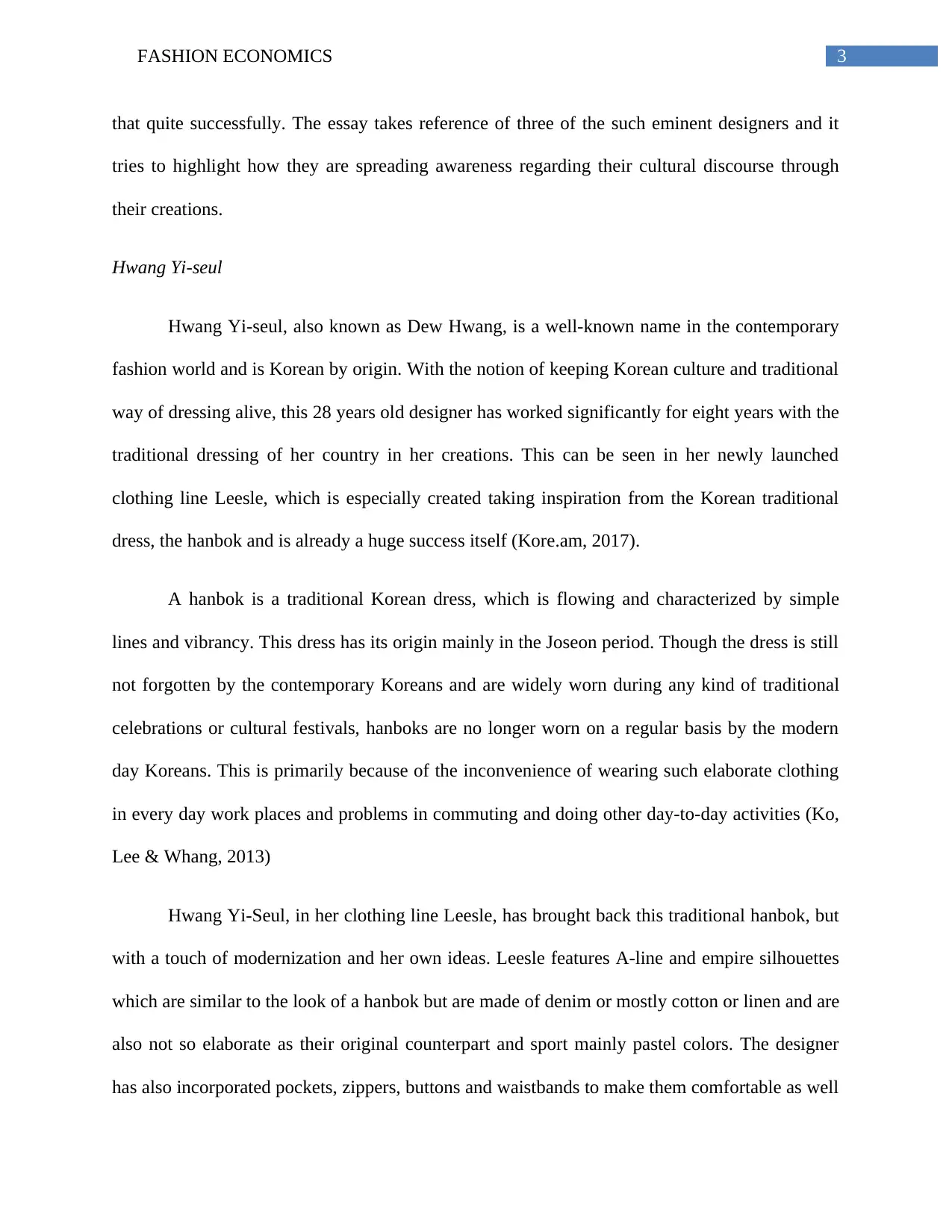
3FASHION ECONOMICS
that quite successfully. The essay takes reference of three of the such eminent designers and it
tries to highlight how they are spreading awareness regarding their cultural discourse through
their creations.
Hwang Yi-seul
Hwang Yi-seul, also known as Dew Hwang, is a well-known name in the contemporary
fashion world and is Korean by origin. With the notion of keeping Korean culture and traditional
way of dressing alive, this 28 years old designer has worked significantly for eight years with the
traditional dressing of her country in her creations. This can be seen in her newly launched
clothing line Leesle, which is especially created taking inspiration from the Korean traditional
dress, the hanbok and is already a huge success itself (Kore.am, 2017).
A hanbok is a traditional Korean dress, which is flowing and characterized by simple
lines and vibrancy. This dress has its origin mainly in the Joseon period. Though the dress is still
not forgotten by the contemporary Koreans and are widely worn during any kind of traditional
celebrations or cultural festivals, hanboks are no longer worn on a regular basis by the modern
day Koreans. This is primarily because of the inconvenience of wearing such elaborate clothing
in every day work places and problems in commuting and doing other day-to-day activities (Ko,
Lee & Whang, 2013)
Hwang Yi-Seul, in her clothing line Leesle, has brought back this traditional hanbok, but
with a touch of modernization and her own ideas. Leesle features A-line and empire silhouettes
which are similar to the look of a hanbok but are made of denim or mostly cotton or linen and are
also not so elaborate as their original counterpart and sport mainly pastel colors. The designer
has also incorporated pockets, zippers, buttons and waistbands to make them comfortable as well
that quite successfully. The essay takes reference of three of the such eminent designers and it
tries to highlight how they are spreading awareness regarding their cultural discourse through
their creations.
Hwang Yi-seul
Hwang Yi-seul, also known as Dew Hwang, is a well-known name in the contemporary
fashion world and is Korean by origin. With the notion of keeping Korean culture and traditional
way of dressing alive, this 28 years old designer has worked significantly for eight years with the
traditional dressing of her country in her creations. This can be seen in her newly launched
clothing line Leesle, which is especially created taking inspiration from the Korean traditional
dress, the hanbok and is already a huge success itself (Kore.am, 2017).
A hanbok is a traditional Korean dress, which is flowing and characterized by simple
lines and vibrancy. This dress has its origin mainly in the Joseon period. Though the dress is still
not forgotten by the contemporary Koreans and are widely worn during any kind of traditional
celebrations or cultural festivals, hanboks are no longer worn on a regular basis by the modern
day Koreans. This is primarily because of the inconvenience of wearing such elaborate clothing
in every day work places and problems in commuting and doing other day-to-day activities (Ko,
Lee & Whang, 2013)
Hwang Yi-Seul, in her clothing line Leesle, has brought back this traditional hanbok, but
with a touch of modernization and her own ideas. Leesle features A-line and empire silhouettes
which are similar to the look of a hanbok but are made of denim or mostly cotton or linen and are
also not so elaborate as their original counterpart and sport mainly pastel colors. The designer
has also incorporated pockets, zippers, buttons and waistbands to make them comfortable as well
Paraphrase This Document
Need a fresh take? Get an instant paraphrase of this document with our AI Paraphraser
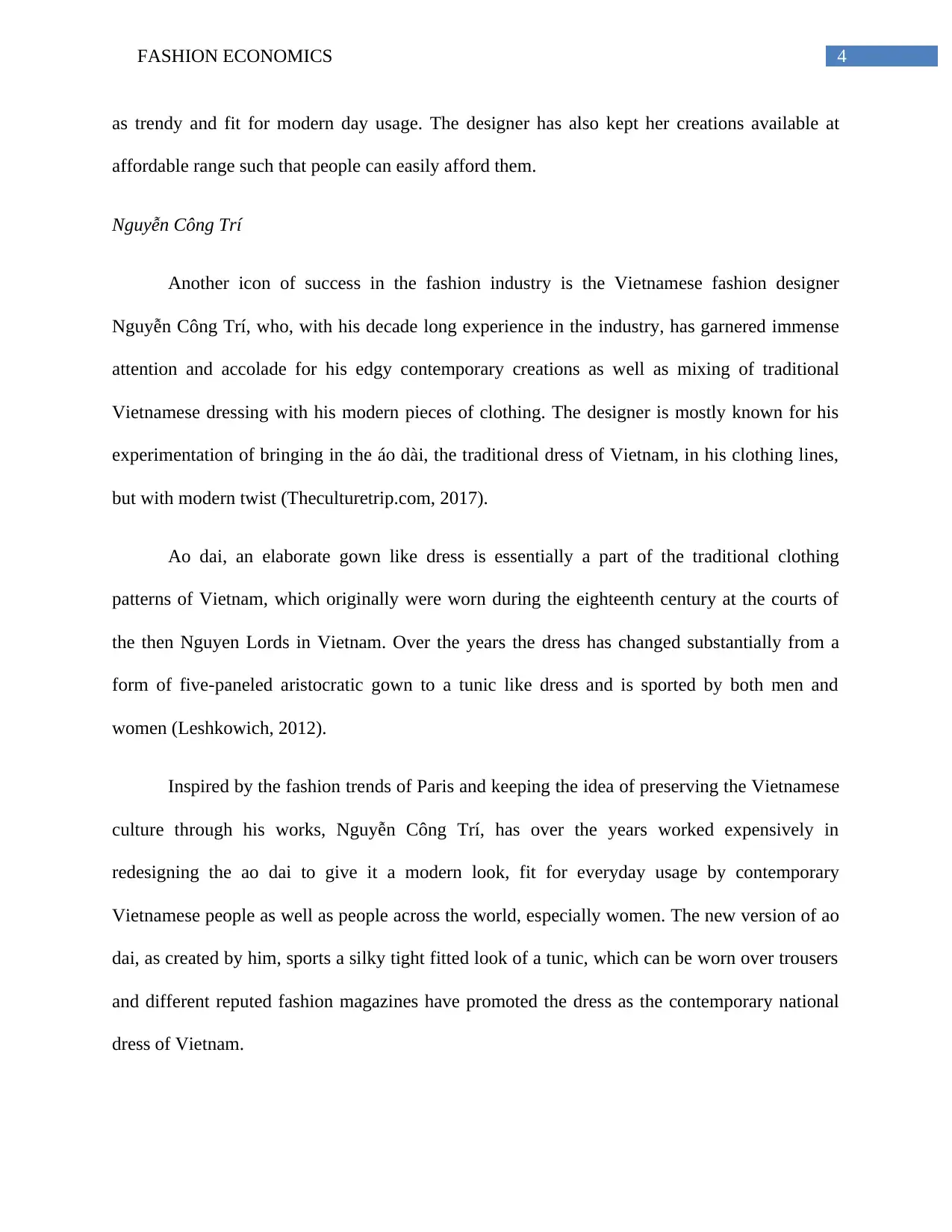
4FASHION ECONOMICS
as trendy and fit for modern day usage. The designer has also kept her creations available at
affordable range such that people can easily afford them.
Nguyễn Công Trí
Another icon of success in the fashion industry is the Vietnamese fashion designer
Nguyễn Công Trí, who, with his decade long experience in the industry, has garnered immense
attention and accolade for his edgy contemporary creations as well as mixing of traditional
Vietnamese dressing with his modern pieces of clothing. The designer is mostly known for his
experimentation of bringing in the áo dài, the traditional dress of Vietnam, in his clothing lines,
but with modern twist (Theculturetrip.com, 2017).
Ao dai, an elaborate gown like dress is essentially a part of the traditional clothing
patterns of Vietnam, which originally were worn during the eighteenth century at the courts of
the then Nguyen Lords in Vietnam. Over the years the dress has changed substantially from a
form of five-paneled aristocratic gown to a tunic like dress and is sported by both men and
women (Leshkowich, 2012).
Inspired by the fashion trends of Paris and keeping the idea of preserving the Vietnamese
culture through his works, Nguyễn Công Trí, has over the years worked expensively in
redesigning the ao dai to give it a modern look, fit for everyday usage by contemporary
Vietnamese people as well as people across the world, especially women. The new version of ao
dai, as created by him, sports a silky tight fitted look of a tunic, which can be worn over trousers
and different reputed fashion magazines have promoted the dress as the contemporary national
dress of Vietnam.
as trendy and fit for modern day usage. The designer has also kept her creations available at
affordable range such that people can easily afford them.
Nguyễn Công Trí
Another icon of success in the fashion industry is the Vietnamese fashion designer
Nguyễn Công Trí, who, with his decade long experience in the industry, has garnered immense
attention and accolade for his edgy contemporary creations as well as mixing of traditional
Vietnamese dressing with his modern pieces of clothing. The designer is mostly known for his
experimentation of bringing in the áo dài, the traditional dress of Vietnam, in his clothing lines,
but with modern twist (Theculturetrip.com, 2017).
Ao dai, an elaborate gown like dress is essentially a part of the traditional clothing
patterns of Vietnam, which originally were worn during the eighteenth century at the courts of
the then Nguyen Lords in Vietnam. Over the years the dress has changed substantially from a
form of five-paneled aristocratic gown to a tunic like dress and is sported by both men and
women (Leshkowich, 2012).
Inspired by the fashion trends of Paris and keeping the idea of preserving the Vietnamese
culture through his works, Nguyễn Công Trí, has over the years worked expensively in
redesigning the ao dai to give it a modern look, fit for everyday usage by contemporary
Vietnamese people as well as people across the world, especially women. The new version of ao
dai, as created by him, sports a silky tight fitted look of a tunic, which can be worn over trousers
and different reputed fashion magazines have promoted the dress as the contemporary national
dress of Vietnam.
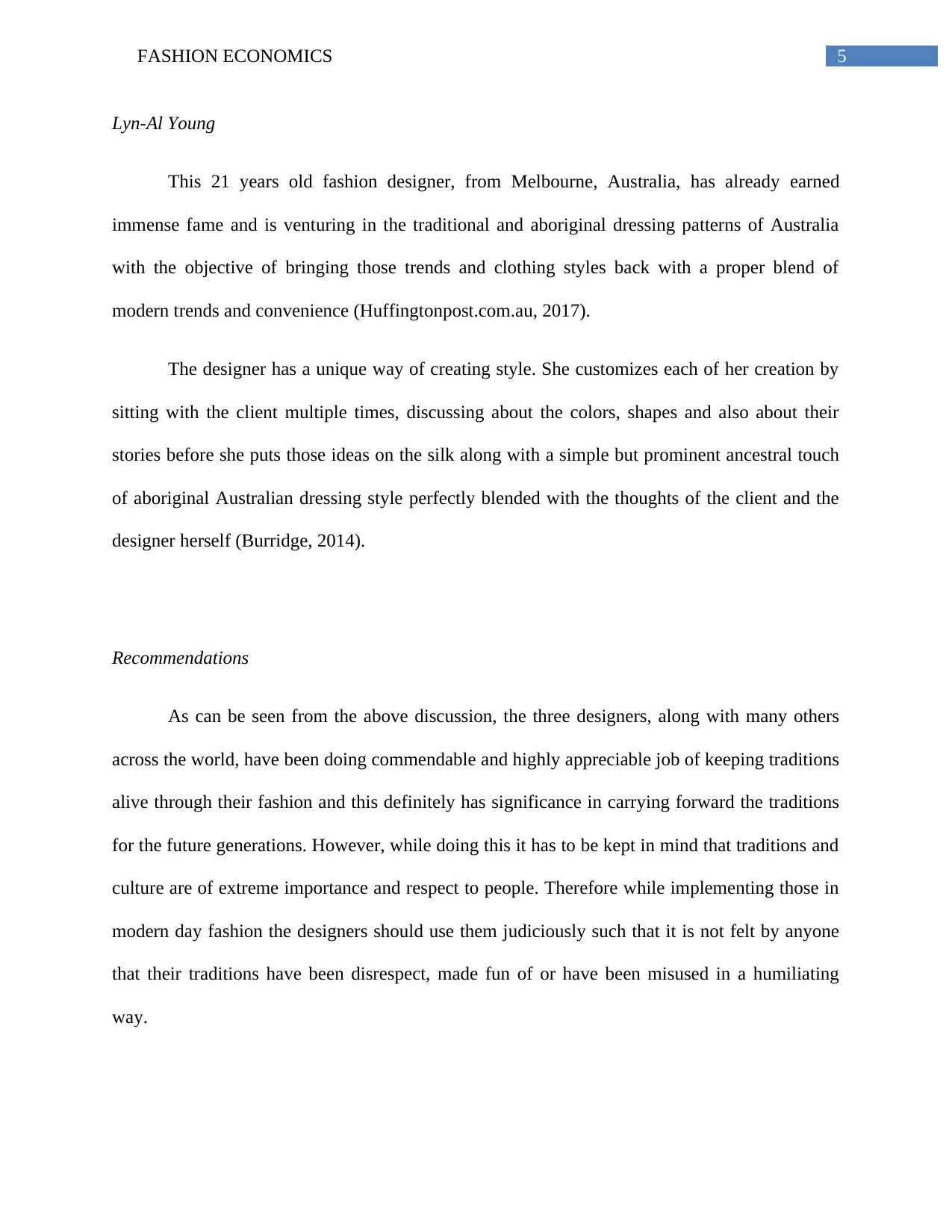
5FASHION ECONOMICS
Lyn-Al Young
This 21 years old fashion designer, from Melbourne, Australia, has already earned
immense fame and is venturing in the traditional and aboriginal dressing patterns of Australia
with the objective of bringing those trends and clothing styles back with a proper blend of
modern trends and convenience (Huffingtonpost.com.au, 2017).
The designer has a unique way of creating style. She customizes each of her creation by
sitting with the client multiple times, discussing about the colors, shapes and also about their
stories before she puts those ideas on the silk along with a simple but prominent ancestral touch
of aboriginal Australian dressing style perfectly blended with the thoughts of the client and the
designer herself (Burridge, 2014).
Recommendations
As can be seen from the above discussion, the three designers, along with many others
across the world, have been doing commendable and highly appreciable job of keeping traditions
alive through their fashion and this definitely has significance in carrying forward the traditions
for the future generations. However, while doing this it has to be kept in mind that traditions and
culture are of extreme importance and respect to people. Therefore while implementing those in
modern day fashion the designers should use them judiciously such that it is not felt by anyone
that their traditions have been disrespect, made fun of or have been misused in a humiliating
way.
Lyn-Al Young
This 21 years old fashion designer, from Melbourne, Australia, has already earned
immense fame and is venturing in the traditional and aboriginal dressing patterns of Australia
with the objective of bringing those trends and clothing styles back with a proper blend of
modern trends and convenience (Huffingtonpost.com.au, 2017).
The designer has a unique way of creating style. She customizes each of her creation by
sitting with the client multiple times, discussing about the colors, shapes and also about their
stories before she puts those ideas on the silk along with a simple but prominent ancestral touch
of aboriginal Australian dressing style perfectly blended with the thoughts of the client and the
designer herself (Burridge, 2014).
Recommendations
As can be seen from the above discussion, the three designers, along with many others
across the world, have been doing commendable and highly appreciable job of keeping traditions
alive through their fashion and this definitely has significance in carrying forward the traditions
for the future generations. However, while doing this it has to be kept in mind that traditions and
culture are of extreme importance and respect to people. Therefore while implementing those in
modern day fashion the designers should use them judiciously such that it is not felt by anyone
that their traditions have been disrespect, made fun of or have been misused in a humiliating
way.
⊘ This is a preview!⊘
Do you want full access?
Subscribe today to unlock all pages.

Trusted by 1+ million students worldwide
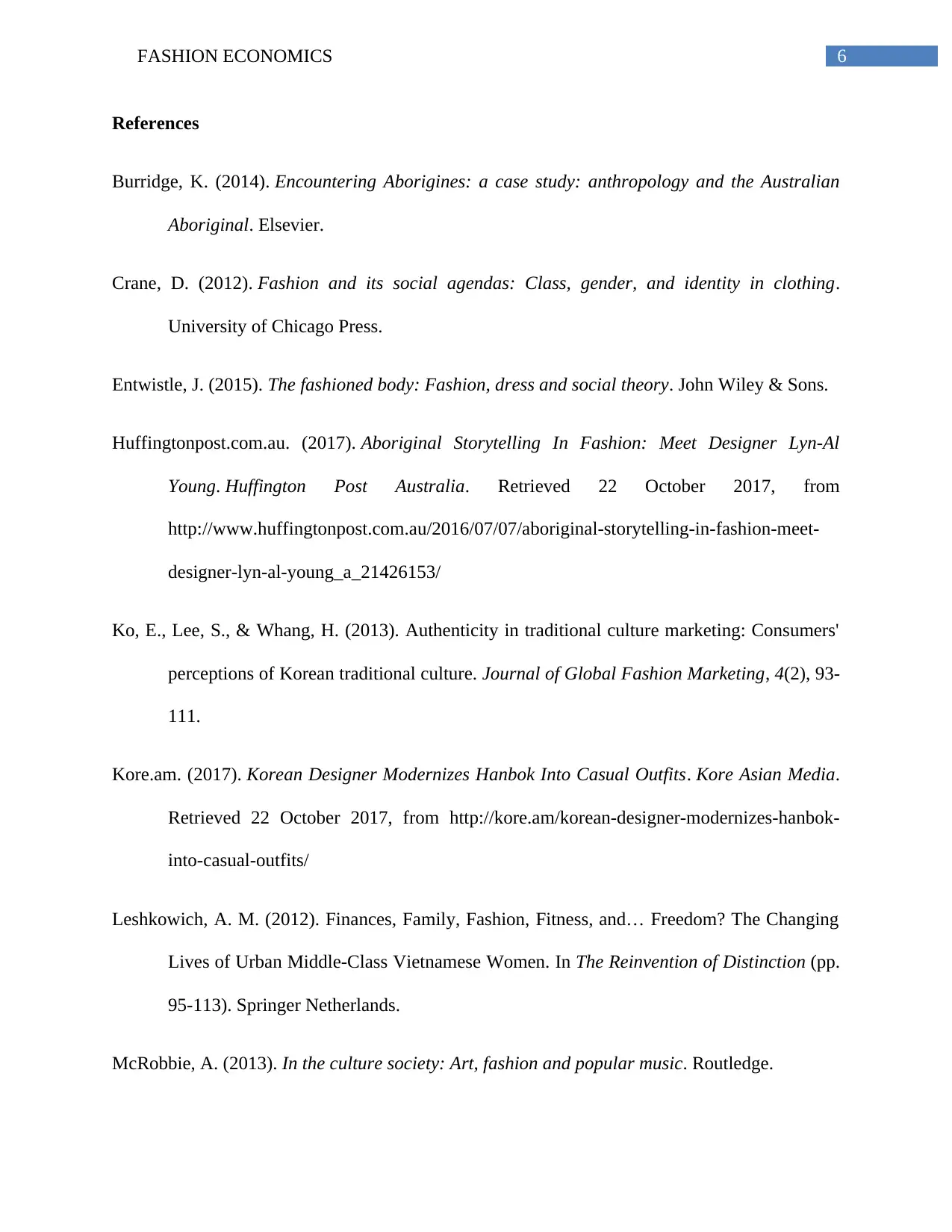
6FASHION ECONOMICS
References
Burridge, K. (2014). Encountering Aborigines: a case study: anthropology and the Australian
Aboriginal. Elsevier.
Crane, D. (2012). Fashion and its social agendas: Class, gender, and identity in clothing.
University of Chicago Press.
Entwistle, J. (2015). The fashioned body: Fashion, dress and social theory. John Wiley & Sons.
Huffingtonpost.com.au. (2017). Aboriginal Storytelling In Fashion: Meet Designer Lyn-Al
Young. Huffington Post Australia. Retrieved 22 October 2017, from
http://www.huffingtonpost.com.au/2016/07/07/aboriginal-storytelling-in-fashion-meet-
designer-lyn-al-young_a_21426153/
Ko, E., Lee, S., & Whang, H. (2013). Authenticity in traditional culture marketing: Consumers'
perceptions of Korean traditional culture. Journal of Global Fashion Marketing, 4(2), 93-
111.
Kore.am. (2017). Korean Designer Modernizes Hanbok Into Casual Outfits. Kore Asian Media.
Retrieved 22 October 2017, from http://kore.am/korean-designer-modernizes-hanbok-
into-casual-outfits/
Leshkowich, A. M. (2012). Finances, Family, Fashion, Fitness, and… Freedom? The Changing
Lives of Urban Middle-Class Vietnamese Women. In The Reinvention of Distinction (pp.
95-113). Springer Netherlands.
McRobbie, A. (2013). In the culture society: Art, fashion and popular music. Routledge.
References
Burridge, K. (2014). Encountering Aborigines: a case study: anthropology and the Australian
Aboriginal. Elsevier.
Crane, D. (2012). Fashion and its social agendas: Class, gender, and identity in clothing.
University of Chicago Press.
Entwistle, J. (2015). The fashioned body: Fashion, dress and social theory. John Wiley & Sons.
Huffingtonpost.com.au. (2017). Aboriginal Storytelling In Fashion: Meet Designer Lyn-Al
Young. Huffington Post Australia. Retrieved 22 October 2017, from
http://www.huffingtonpost.com.au/2016/07/07/aboriginal-storytelling-in-fashion-meet-
designer-lyn-al-young_a_21426153/
Ko, E., Lee, S., & Whang, H. (2013). Authenticity in traditional culture marketing: Consumers'
perceptions of Korean traditional culture. Journal of Global Fashion Marketing, 4(2), 93-
111.
Kore.am. (2017). Korean Designer Modernizes Hanbok Into Casual Outfits. Kore Asian Media.
Retrieved 22 October 2017, from http://kore.am/korean-designer-modernizes-hanbok-
into-casual-outfits/
Leshkowich, A. M. (2012). Finances, Family, Fashion, Fitness, and… Freedom? The Changing
Lives of Urban Middle-Class Vietnamese Women. In The Reinvention of Distinction (pp.
95-113). Springer Netherlands.
McRobbie, A. (2013). In the culture society: Art, fashion and popular music. Routledge.
Paraphrase This Document
Need a fresh take? Get an instant paraphrase of this document with our AI Paraphraser
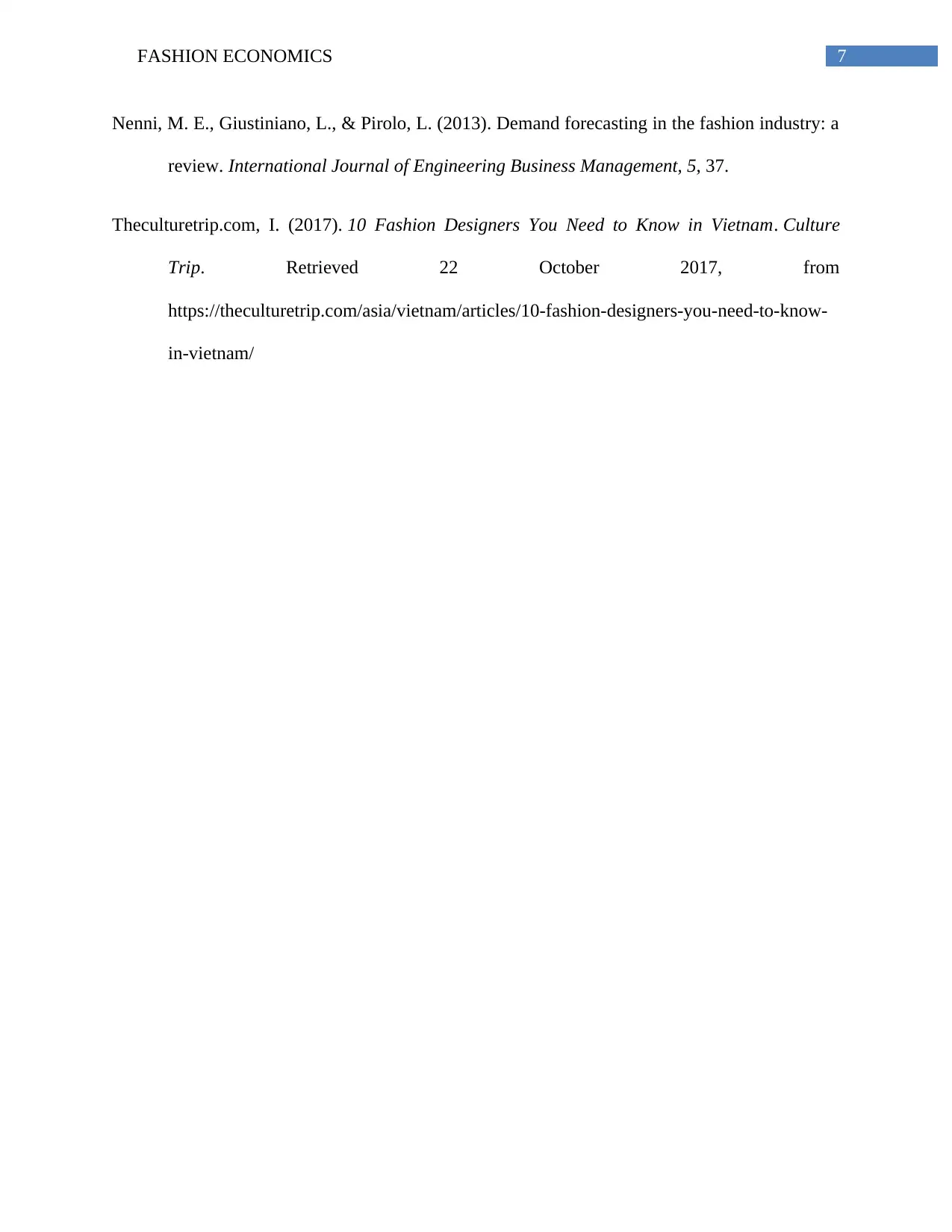
7FASHION ECONOMICS
Nenni, M. E., Giustiniano, L., & Pirolo, L. (2013). Demand forecasting in the fashion industry: a
review. International Journal of Engineering Business Management, 5, 37.
Theculturetrip.com, I. (2017). 10 Fashion Designers You Need to Know in Vietnam. Culture
Trip. Retrieved 22 October 2017, from
https://theculturetrip.com/asia/vietnam/articles/10-fashion-designers-you-need-to-know-
in-vietnam/
Nenni, M. E., Giustiniano, L., & Pirolo, L. (2013). Demand forecasting in the fashion industry: a
review. International Journal of Engineering Business Management, 5, 37.
Theculturetrip.com, I. (2017). 10 Fashion Designers You Need to Know in Vietnam. Culture
Trip. Retrieved 22 October 2017, from
https://theculturetrip.com/asia/vietnam/articles/10-fashion-designers-you-need-to-know-
in-vietnam/
1 out of 8
Related Documents
Your All-in-One AI-Powered Toolkit for Academic Success.
+13062052269
info@desklib.com
Available 24*7 on WhatsApp / Email
![[object Object]](/_next/static/media/star-bottom.7253800d.svg)
Unlock your academic potential
Copyright © 2020–2025 A2Z Services. All Rights Reserved. Developed and managed by ZUCOL.





